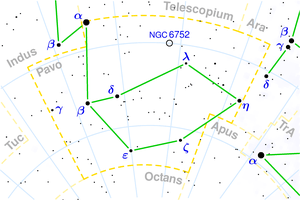|
|
Pavo ( Latin: peacock) is a southern constellation. The constellation was one of twelve constellations created by Pieter Dirkszoon Keyser and Frederick de Houtman between 1595 and 1597, and it first appeared in Johann Bayer's Uranometria of 1603. In Australia "the Saucepan" is sometimes used as an informal name for part of the constellation of Pavo, when finding the south by the stars. The most famous star in the constellation is δ Pavonis, a nearby Sun-like but more evolved star. φ2 Pavonis, another Sun-like star has an unconfirmed extrasolar planet. History Zeus sent Hermes with the task of rescuing Io. To avoid detection by one of Argus' one hundred eyes, Hermes charmed the monster with a flute when it was fast asleep, then threw a huge boulder on top of it, and for good measure cut off its head. An angry Hera set a gadfly to pester Io, who then roamed around most of the Mediterranean nations before finally settling down in Egypt, where Zeus changed her back into human form. She later established the worship of Isis in Egypt.As for the unfortunate Argus, Hera put all of its many eyes on the tail of her sacred bird, the peacock. References * Ian Ridpath and Wil Tirion (2007). Stars and Planets Guide Links
Retrieved from "http://en.wikipedia.org/"
|
|
||||||||||||||||||||||||||||||||||||||||||||||||||||
